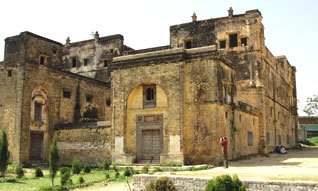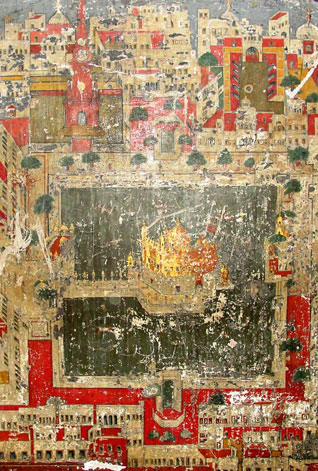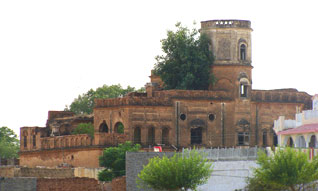
Photos by author. Above: Atam Singh's Haveli (Daultala). Below, 2nd & 3rd from bottom: Khem Singh Bedi's Haveli (Kallar Syedan) & Golden Temple fresco. 1st from bottom: Bakhshi Ram Singh's Haveli (Kontrilla).



Architecture
Specimens Of Architectural Beauty:
The Sikh Havelis of Potohar
ZULFIQAR ALI KALHORO
Potohar, West Punjab (now in Pakistan)
In the year 2000, I was invited by a fellow anthropologist to see the Katas Raj.
The visit left me so mesmerised that I decided to explore the entire Potohar region. So over the past decade-and-a-half, I have kept travelling back to the region, documenting historic buildings and indigenous tribes, and returning from every visit even more amazed at the specimens of the architectural beauty in this region.
Every time I had a break from studies or official work, I rushed to Gujar Khan, Kallar Syedan, Sagri, Daultala, Sukho, Dora Badhal, Beval, Doberan Kallan, Hazro, Kot Fateh Khan, Qutbal, Harnal or Haryal to visit the wondrous gurdwaras, temples and havelis.
The distinctive features of Potohar's havelis have always attracted me.
These havelis belonged to Sikh, Muslim and Hindu notables.
The word 'haveli' is of Persian origin, meaning a great mansion associated with wealth, status and size. In architectural terms, the haveli was merely a very grand version of the modern urban house.
A small list of the havelis in the small and big towns of Potohar include the Khem Singh Bedi haveli in Kallar Syedan, Atam Singh Gujral and Jeevan Singh havelis in Daultana town, Sikh and Hindu havelis in Narali, a haveli of Bakhshi Ram in Kontrilla, a haveli of Ratan Singh in Sagri, and several others in Gulyana and Dora Badhal villages.
Some of the common elements which stood out in all havelis were the 'jharokas', carved wooden doors and wall paintings, reflecting the taste and aesthetics of the builder. One such ornately carved door can be seen in the haveli of Dr Zaman in Basali village, Rawalpindi district.
The jharoka held an important place with both the artist and the owner. These small, enclosed balconies were generally built on the upper floors, and used by both males and females.
Locals, including the present occupant of the havelis, told me that the central jharoka was always occupied by male members of the family, while the flanking jharoka was used by the women. Chaudhry Sajjad Hussian, an oral historian in Gujar Khan, explained that the number of windows and jharokas indicated the affluence of the owner.
Then, there are the towers; splendid towers surmounting the top of the havelis. The most beautiful ones I have seen are found in the havelis of Bakhshi Ram Singh at Kontrilla and in a haveli in Wah town. They were designed to offer a panoramic view of the town or village.
Passing through the narrow alleys of Kallar Syedan, one gets to the imposing Khem Singh Bedi haveli, which was turned into a school after Partition.
I appreciate that the school staff or students have taken care not to deface any of the figures decorating the haveli's interior. Most of the haveli's rooms are adorned with paintings depicting the Sikh Gurus, saints, Baba Sri Chand (the eldest son of Guru Nanak) and scenes from Indian mythology.
I often wonder why the government of Punjab is not making serious efforts to promote tourism in the Potohar region; currently, the only known tourist destination in Potohar is Katas Raj.
Like in Rajasthan, where the havelis have been turned into hotels to promote heritage tourism, the Punjab government too should follow the same model and declare all the havelis here as heritage sites. Not only will that promote heritage tourism, it will also create more job opportunities for the wonderful locals of Potohar.
Zulfiqar Ali Kalhoro is an anthropologist and teaches tourism, globalisation and development at the Pakistan Institute of Development Economics, Islamabad.
[Courtesy: Dawn. Edited for sikhchic.com]
June 15, 2015
Conversation about this article
1: Sangat Singh (Kuala Lumpur, Malaysia), June 16, 2015, 8:54 PM.
This is the common 'virsa' / heritage that belongs to all Punjabis, regardless of the artificial line that divides Punjab today. Thanks to Zulfiqar Ali ji for his efforts to preserve the common rich virsa.
2: Harsaran Singh (Indonesia), June 17, 2015, 10:00 AM.
Firstly I would like to compliment Sikhchic.com for bringing two excellent corresponding articles on the history and legacy of our heritage in present day Pak Panjab. But sadly both of these articles do not bear good news. While the havelis of Potohar are in dire need of upkeep, the other article by Rana Tanveer speaks about how historic landmarks named after Gurus and heroes are being renamed by petty politicians. As S. Sangat Singh ji has mentioned, this has nothing to do with religion, it is the common Virsa and Punjabiyat which needs to be safeguarded. My request to the Editor is to start a dialogue on this pressing topic so that we can get input from fellow readers and also our intelligentsia about finding ways to safeguard these national treasures. Joseph Joubert has rightly said: "Monuments are grappling-irons that bind one generation to another." Let us take initiative and work towards conservation and restoration of our precious history.


